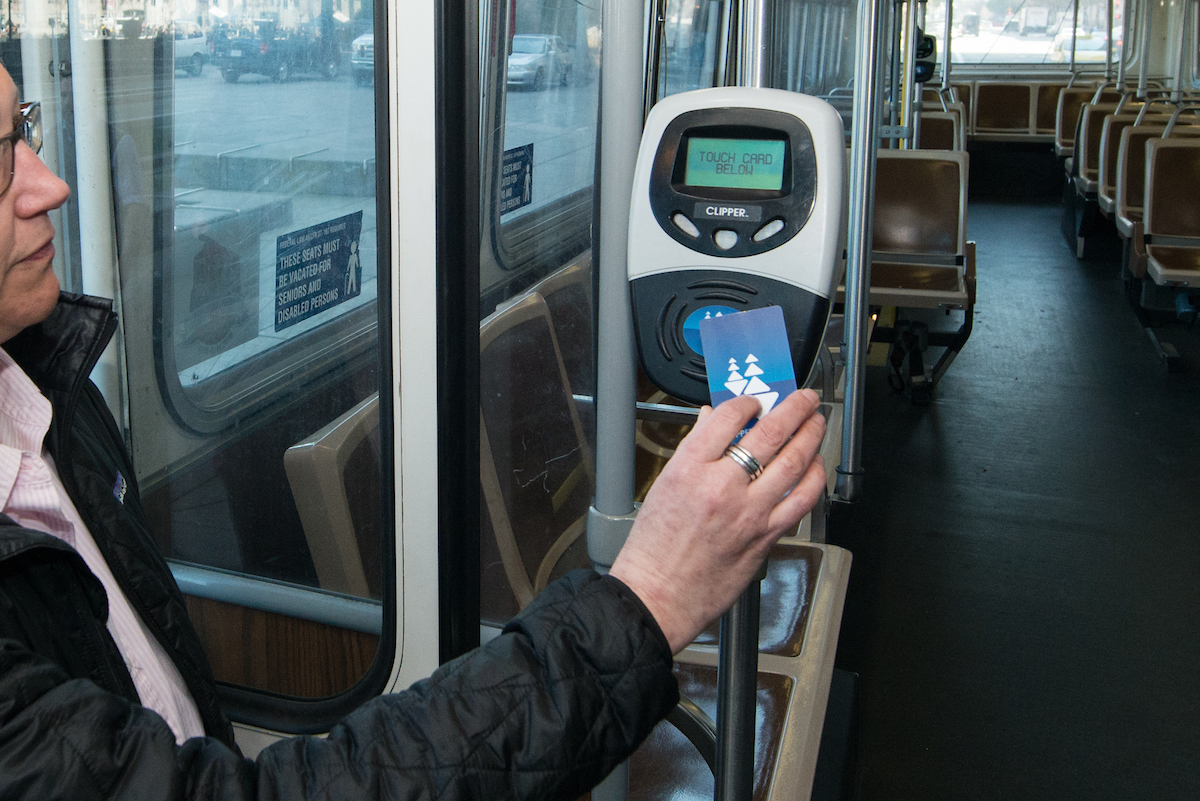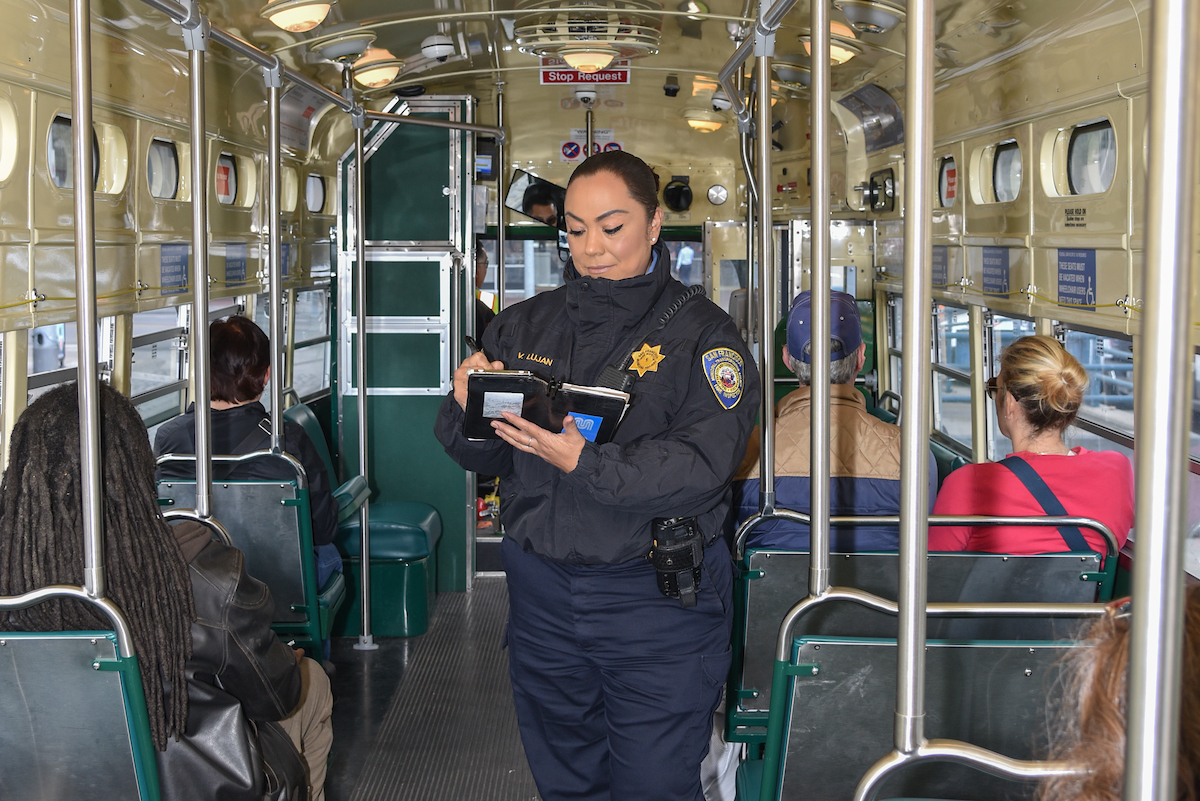 Tapping a Clipper card is one of the many ways to pay to ride Muni.
Tapping a Clipper card is one of the many ways to pay to ride Muni.
Maybe this has happened to you: You board Muni and tap your Clipper card or pay your cash fare, but lots of other people get on without doing the same. We understand how frustrating it is to see people appear to cheat the system and ride for free. However, most people who don’t tap the Clipper card reader or pay at the fare box aren’t doing anything wrong.
At the same time, fare evasion has increased over the last few years. We take this issue seriously and are doing something about it. We plan to hire more fare inspectors once our upcoming budget goes into effect.
Looks can be deceiving when it comes to paying fares
There are many ways to pay Muni fares, including with cash, Clipper and the Muni Mobile app. Discount fares and passes are available for certain riders.
Some passengers are allowed to ride Muni for free. Young people 18 and under ride for free and don’t need any kind of pass or special ticket. Seniors with lower incomes, people with disabilities and people experiencing homelessness can apply for passes to ride for free. You can learn about all the ways to pay for Muni and our free or discounted pass programs at our Fares webpage (SFMTA.com/Fares).
It’s important to know that it may look like someone hasn’t paid their fare when, in fact, they have. Many of our programs allow riders to pay before boarding. For example:
-
With Muni Mobile, you activate your ticket in the app and don’t need to tap or show the operator anything.
-
If you buy single or multi-day visitor passports, you only need to tap if you load them onto a Clipper card.
-
If you transfer from one route or line to another after paying cash, you can board without showing the operator your paper ticket.
-
Tickets to events at the Chase Center include unlimited rides on Muni, except for the cable cars. No need to tap or show anything.
Just remember to keep proof of payment with you when you pay your fare. That could be your ticket, app, Clipper card or pass.
Increase in fare evasion
Most Muni riders pay their fares. But too many others do not, and fare evasion is on the rise. Before the Covid-19 pandemic, around 12% of people on Muni who should have paid a fare did not. We believe that number has grown to just over 20% today and are working to confirm that estimate.
Our ridership continues to increase and is up to 76% of pre-pandemic levels, as of March 2024. But we aren’t reaping the full financial benefit of that recovery because of fare evasion. Muni is a public service and a public good. The system is critical to our city’s climate goals and its economic vitality. It also promotes social and racial equity. It isn’t right to let some people choose not to pay their fair share.
 Transit Fare Inspector Veronica Lujan checks fare compliance on the F Market line.
Transit Fare Inspector Veronica Lujan checks fare compliance on the F Market line.
More fare inspectors
To cut down on fare evasion, we plan to hire three dozen additional transit fare inspectors. We have allocated money in our upcoming two-year budget to pay for these positions.
Our fare inspectors work on routes and lines throughout the entire Muni system in a way that is fair and equitable. The inspectors are there to encourage compliance and increase fare revenue, not punish people. The more riders see our fare inspectors on Muni, the more likely it is that people will pay their fares. We are not trying to make money by writing tickets.
Our inspectors also help riders in other ways:
-
They have information about our fares, including our discount pass programs.
-
They educate anyone who hasn’t paid, instead of just citing them.
-
They have information about supportive services for riders who may be experiencing homelessness.
-
Their presence encourages safety and security on Muni, even though they aren’t part of law enforcement.
Fare inspectors are there to support riders, and we are looking forward to offering more of that support.
More uniform payment methods
We know that the different fare payment methods can be confusing, especially when some people have to tap a card reader and others do not. But there is good news. The Metropolitan Transportation Commission is working to update Clipper card technology. This will allow us to offer more fare options and passes on Clipper. Plus, people will be able to tap a credit card to pay fares. This should result in more people tagging card readers when they board and all riders feeling more confident that their fellow passengers are paying their fair share.
Muni depends on your support. Fares keep the system running. They help pay for programs that have made Muni faster, safer, more reliable and cleaner than it has been in decades. Put simply, fares help hundreds of thousands of people get around every day.
Every dollar invested in Muni goes a long way. When we all do our part by paying the appropriate fare to ride, Muni can serve everyone better.